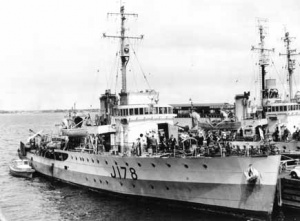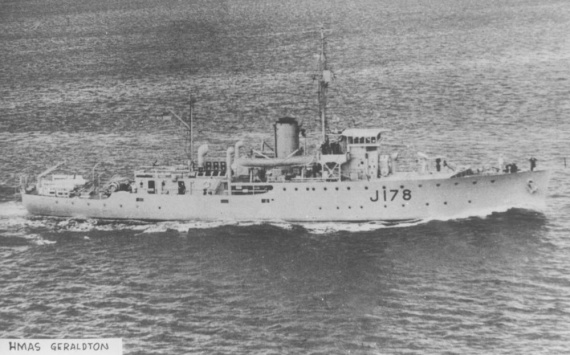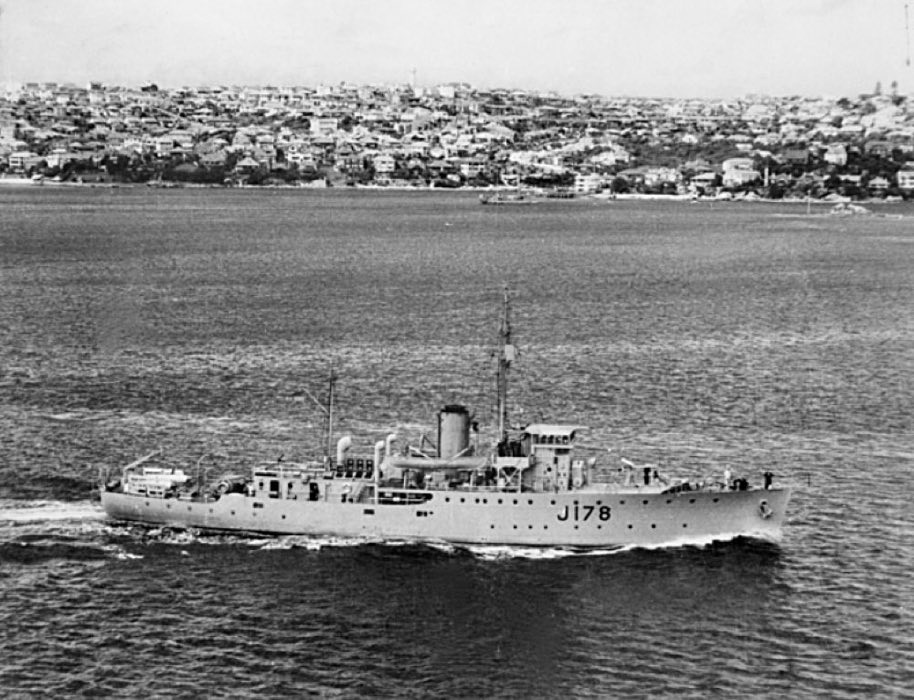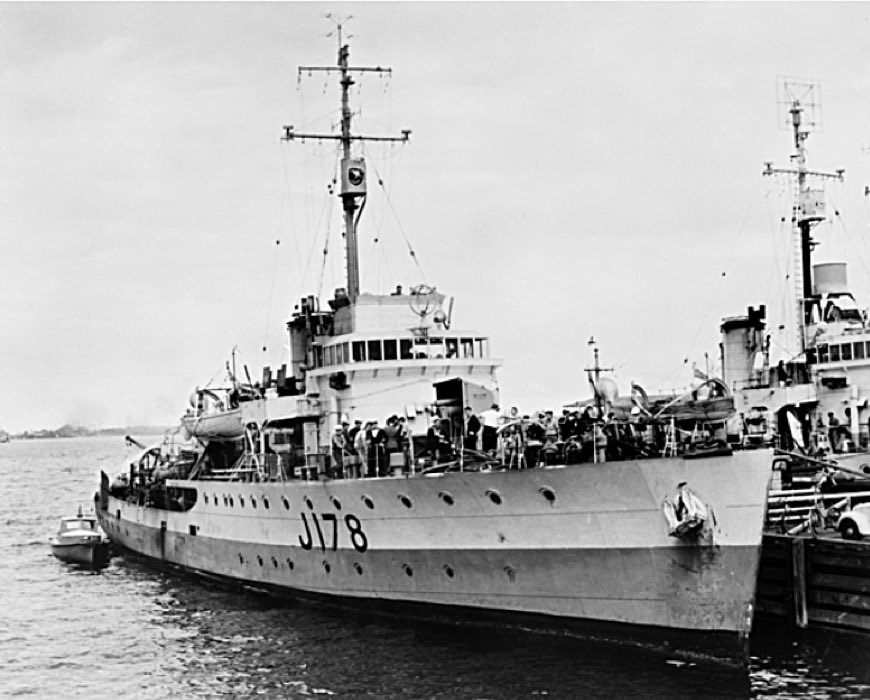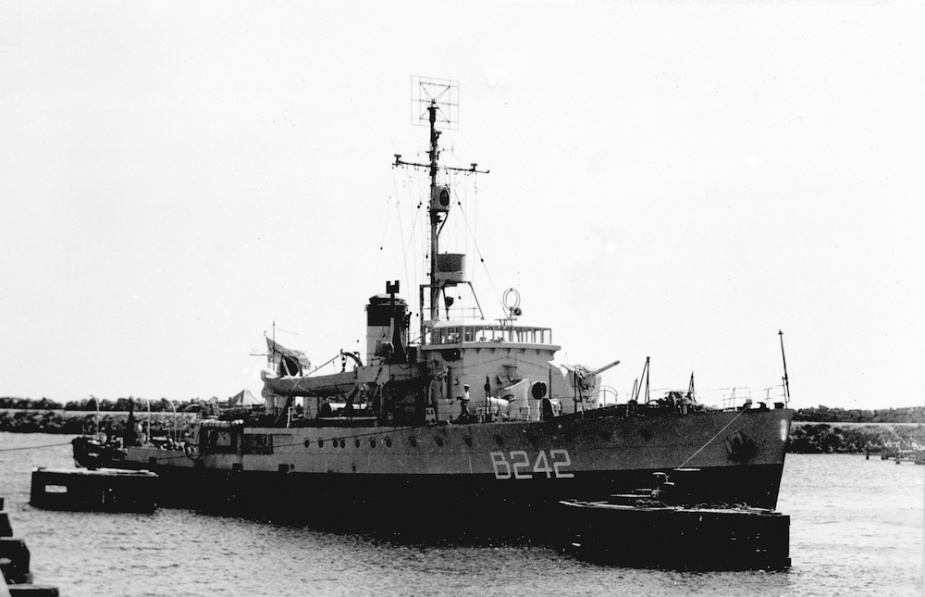HMAS Geraldton (I)
| Class |
Bathurst Class |
|---|---|
| Type |
Australian Minesweeper |
| Pennant |
J178, B242 and A116 |
| Builder |
Poole and Steel Ltd, Sydney |
| Laid Down |
20 November 1940 |
| Launched |
16 August 1941 |
| Launched by |
Mrs McKell, wife of Premier of New South Wales |
| Commissioned |
6 April 1942 |
| Decommissioned |
14 June 1946 |
| Dimensions & Displacement | |
| Displacement | 650 tons |
| Length | 186 feet |
| Beam | 31 feet |
| Draught | 8 feet 6 inches |
| Performance | |
| Speed | 15 knots |
| Complement | |
| Crew | 85 |
| Propulsion | |
| Machinery | Triple expansion, 2 shafts |
| Horsepower | 2000 |
| Armament | |
| Guns |
|
| Other Armament |
|
| Awards | |
| Battle Honours | |
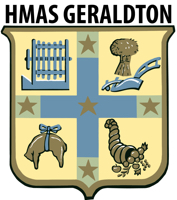
HMAS Geraldton was one of sixty Australian Minesweepers (commonly known as corvettes) built during World War II in Australian shipyards as part of the Commonwealth Government's wartime shipbuilding programme. Twenty (including Geraldton) were built on Admiralty order but manned and commissioned by the Royal Australian Navy. Thirty six were built for the Royal Australian Navy and four for the Royal Indian Navy.
HMAS Geraldton was laid down at Poole and Steel Ltd, Sydney, NSW on 20 November 1940. She was launched on 16 August 1941 by Mrs McKell, wife of Premier of New South Wales and was the first RAN warship to carry the name of the coastal city in the mid-west region of WA, located located 424 kilometres north of Perth.
Geraldton commissioned at Sydney on 6 April 1942 under the command of Lieutenant Commander Harold M Harris RNR.
For a short period after commissioning Geraldton was employed on patrol duties off the east coast of Australia. She then left to join the Eastern Fleet, departing Fremantle on 26 July 1942, escorting the tanker Bahrein to Addu Atoll, where she arrived on 8 August, before proceeding on to Colombo. Two of her sister ships, HMA Ships Bathurst and Lismore, were already serving with the Eastern Fleet, and more of her sister ships arrived in the following months from Australia.
On 25 August Geraldton conducted an unsuccessful search for survivors of the Harmonides, which had been sunk by a submarine. On 6 September 1942 she sailed from Bombay escorting her first Persian Gulf bound convoy.
Returning from Aden with a convoy on 29 September 1942, Geraldton attached, without any tangible result, a strong submarine contact in the Gulf of Oman. She continued to escort convoys to and from the Persian Gulf throughout the remainder of 1942. Convoys were predominantly from Colombo and Bombay to Basra, Aden and the Persian Gulf. One such convoy, escorted by Geraldton and HMIS Bengal in November 1942, comprised 27 ships.
In May 1943 Geraldton was transferred temporarily to the Mediterranean, forming the 22nd Minesweeping Flotilla with her sister ships HMA Ships Cessnock (I), Cairns (I) and Wollongong.
While serving in the Mediterranean theatre Geraldton participated in Operation HUSKY, the Allied invasion of Sicily, which commenced on 10 July. Three days later, Geraldton was on patrol off Sicily.
Geraldton continued convoy escort duty for the remainder of her stay in the Mediterranean. In August 1943 she entered the Atlantic Ocean to rendezvous with a Mediterranean bound convoy for she which she acted as one of the convoy escorts.
She returned to convoy work in the Persian Gulf in October 1943, and continued this work between Aden and Bombay and numerous other ports en route to and from the Persian Gulf, until her return to Australia in early 1945.
In November 1944 she was assigned to the 22nd Minesweeping Flotilla, British Pacific Fleet. Geraldton sailed with the Flotilla from Trincomalee, for Australia, on 26 January 1945. She arrived in Fremantle on 9 February.
Following gunnery modifications in Melbourne, Geraldton underwent a refit in Fremantle which commenced in March 1945. She returned to the Australian east coast in June.
After four months service in Australian waters, Geraldton departed Sydney on 20 June 1945 for service in northern waters, escorting elements of the British Pacific Fleet Train to Manus, Eniwetok and Leyte Gulf.
Following the cessation of hostilities, Geraldton departed Leyte on 5 September for Hong Kong, arriving four days later. She was present at Hong Kong for the Japanese surrender ceremony there on 16 September 1945 and supported the transfer of prisoners of war and internees, after which she was engaged on anti-piracy patrols in the Hong Kong area.
On 11 October 1945 Geraldton departed Hong Kong for Australia with the remainder of the 22nd Minesweeping Flotilla, arriving in Brisbane on 29 October for docking and leave. She departed Brisbane on 16 December for the passage to Western Australia, visiting Newcastle, Sydney, Melbourne, Adelaide and Glenelg en oute.
Geraldton arrived in Fremantle on 17 January 1946, and there she remained until sailing for Singapore on 8 May 1946.
Geraldton paid off at Colombo on 14 June 1946 and on 24 August 1946 she was transferred to the Turkish Navy and renamed Antalya.
After her sister ship Ayvalik (ex HMAS Gawler) was withdrawn from Turkish Navy service in 1963, Antalya was renamed Ayvalik. Jane's Fighting Ships reported that Ayvalik was deleted from the Turkish Navy list in 1975.
Note: This video is hosted on YouTube. Department of Defence users will not be able to view this video on the Defence Protected Network.
This cine film has been placed online as part of the Sea Power Centre - Australia’s ongoing archival digitisation program.
Further reading
- The Corvettes: Forgotten Ships of the Royal Australian Navy, by Iris Nesdale - published by the author, October, 1982.
- Notable Service to the Empire: Australian Corvettes and the British Pacific Fleet, 1944-45, by Hugh Campbell - published by Naval Historical Society of Australia Inc, 1995.
- Corvettes - Little Ships for Big Men, by Frank B Walker - published by Kingfisher Press, NSW, 1996.
- The Australian Centenary History of Defence Volume III, The Royal Australian Navy, edited by David Stevens, Oxford University Press, South Melbourne, Victoria, Australia, 2001.

